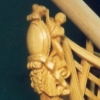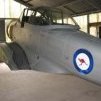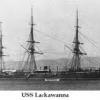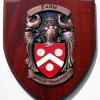-
Posts
1,196 -
Joined
-
Last visited
Reputation Activity
-
 Stuntflyer got a reaction from EdT in HM Cutter Cheerful 1806 by Stuntflyer (Mike) - FINISHED - 1:48 scale
Stuntflyer got a reaction from EdT in HM Cutter Cheerful 1806 by Stuntflyer (Mike) - FINISHED - 1:48 scale
I've been hard at work completing a number of tasks and thought that it would be better to post after all of them were completed. Here are a few notes that might be of interest to others who are building Cheerful.
Before installing the false deck, the four stern frames were thinned down gradually, 1/16" at the top to 1/8" at the bottom.
The 2nd layer of bulwark planking is slightly rounded at its top outside edge where it sits directly below the gun port sills.
The Caprail's fancy molding was added after painting its bottom edge black. It was glued to the caprail using medium CA from the top. Consequently, there was no CA seepage below its bottom edge. The width of the Caprail, which includes its fancy molding, is slightly under 5/32".
After shaping the boarding ladder steps I installed the top one to the hull before starting on the remaining fancy molding. This was easier for me than to try and cut out the space for the top ladder after the molding was glued to the hull. All of the remaining fancy moldings were then added to the hull including the small “ear” at the stem. The moldings are quite thin being under 1/32". I could see that the 1/32" Hawse Plates would stand proud of the molding, which I didn't like, so I made them from .025 sheet.
On the transom, the port lids are stationary with simulated hinge straps using Chuck's Laser Board kit. There are tiny holes in the hinges that are filled with glue during application which aid in holding the hinges in place. They are stiff, easy to paint and easy to install. Highly recommended. Missing are the four hinges on the top of each strap. I am still trying to decide how I want to make them.
Some prep work was necessary before painting the bulwark planking. Using soft 4-6 lb balsa (left over from the airplane building days) I fitted plugs into each gun port to protect them from any overspray. They are only 1/8" thick and were easy to shape and fit into the ports. Then the entire hull including the false deck was masked off. The paint was applied using the Paasche air brush. W&N Galeria Acrylic paint, when properly thinned, does not clog this airbrush. I also noticed that cleaning the airbrush between coats was not necessary. Seven coats were applied.
I laid down some 3M fine line tape inside the hull along the bottom edge of the caprail. Using a black .020 Micron Archival pen, I scribed a line against the tapes edge to establish the bottom of the caprail. Now it was a simple matter of painting from the line up to the top of the caprail.
-
 Stuntflyer got a reaction from Archi in HM Cutter Cheerful 1806 by Stuntflyer (Mike) - FINISHED - 1:48 scale
Stuntflyer got a reaction from Archi in HM Cutter Cheerful 1806 by Stuntflyer (Mike) - FINISHED - 1:48 scale
Except for the two door handles that are missing, the Companion is done. They will go on when I get some wire with the right gauge thickness, 30 or smaller. I only have a 35mm lens so photos of these small objects are not really a good representation since I have to crop the image. This of course decreases sharpness. I can see where a macro lens might come in handy here. Anyway, you should be able to get the general idea of what it looks like.
Now it's back to the hull.
-
 Stuntflyer got a reaction from PeteB in HM Cutter Cheerful 1806 by Stuntflyer (Mike) - FINISHED - 1:48 scale
Stuntflyer got a reaction from PeteB in HM Cutter Cheerful 1806 by Stuntflyer (Mike) - FINISHED - 1:48 scale
I've been hard at work completing a number of tasks and thought that it would be better to post after all of them were completed. Here are a few notes that might be of interest to others who are building Cheerful.
Before installing the false deck, the four stern frames were thinned down gradually, 1/16" at the top to 1/8" at the bottom.
The 2nd layer of bulwark planking is slightly rounded at its top outside edge where it sits directly below the gun port sills.
The Caprail's fancy molding was added after painting its bottom edge black. It was glued to the caprail using medium CA from the top. Consequently, there was no CA seepage below its bottom edge. The width of the Caprail, which includes its fancy molding, is slightly under 5/32".
After shaping the boarding ladder steps I installed the top one to the hull before starting on the remaining fancy molding. This was easier for me than to try and cut out the space for the top ladder after the molding was glued to the hull. All of the remaining fancy moldings were then added to the hull including the small “ear” at the stem. The moldings are quite thin being under 1/32". I could see that the 1/32" Hawse Plates would stand proud of the molding, which I didn't like, so I made them from .025 sheet.
On the transom, the port lids are stationary with simulated hinge straps using Chuck's Laser Board kit. There are tiny holes in the hinges that are filled with glue during application which aid in holding the hinges in place. They are stiff, easy to paint and easy to install. Highly recommended. Missing are the four hinges on the top of each strap. I am still trying to decide how I want to make them.
Some prep work was necessary before painting the bulwark planking. Using soft 4-6 lb balsa (left over from the airplane building days) I fitted plugs into each gun port to protect them from any overspray. They are only 1/8" thick and were easy to shape and fit into the ports. Then the entire hull including the false deck was masked off. The paint was applied using the Paasche air brush. W&N Galeria Acrylic paint, when properly thinned, does not clog this airbrush. I also noticed that cleaning the airbrush between coats was not necessary. Seven coats were applied.
I laid down some 3M fine line tape inside the hull along the bottom edge of the caprail. Using a black .020 Micron Archival pen, I scribed a line against the tapes edge to establish the bottom of the caprail. Now it was a simple matter of painting from the line up to the top of the caprail.
-
 Stuntflyer reacted to rafine in Cutter Cheerful 1806 by rafine - FINISHED
Stuntflyer reacted to rafine in Cutter Cheerful 1806 by rafine - FINISHED
It has rained for several days in usually sunny south Florida. Rain means no golf. No golf means more modeling. All of this is a long way to say that I've done a number of items of work on the hull. Included in this list are the opening for the rudder in the transom and the extension of the stern post; the stern gun port lids; the timber heads; the hull steps; the jib outhaul fixed block on the stem; and the scuppers.
All of this work was straightforward and doesn't seem to require explanation. The last photo shows the hull as it looks to this point. I am now working on the channels and waiting for the arrival of brass strip for the chainplates.
Bob
-
 Stuntflyer got a reaction from Canute in 18th Century Longboat by Erik W - FINISHED - Model Shipways - Scale 1:48 - First wooden ship build
Stuntflyer got a reaction from Canute in 18th Century Longboat by Erik W - FINISHED - Model Shipways - Scale 1:48 - First wooden ship build
Erik,
I used the kit supplied wire to make the Chainplates for my Longboat. After sanding the wire to remove the outside finish I was able to solder the wire. After some cleanup, I sprayed the wire with Krylon primer and painted with model expo paint. No problem with adhesion.
Mike
-
 Stuntflyer got a reaction from mtaylor in 18th Century Longboat by Erik W - FINISHED - Model Shipways - Scale 1:48 - First wooden ship build
Stuntflyer got a reaction from mtaylor in 18th Century Longboat by Erik W - FINISHED - Model Shipways - Scale 1:48 - First wooden ship build
Erik,
I used the kit supplied wire to make the Chainplates for my Longboat. After sanding the wire to remove the outside finish I was able to solder the wire. After some cleanup, I sprayed the wire with Krylon primer and painted with model expo paint. No problem with adhesion.
Mike
-
 Stuntflyer got a reaction from Erik W in 18th Century Longboat by Erik W - FINISHED - Model Shipways - Scale 1:48 - First wooden ship build
Stuntflyer got a reaction from Erik W in 18th Century Longboat by Erik W - FINISHED - Model Shipways - Scale 1:48 - First wooden ship build
Erik,
I used the kit supplied wire to make the Chainplates for my Longboat. After sanding the wire to remove the outside finish I was able to solder the wire. After some cleanup, I sprayed the wire with Krylon primer and painted with model expo paint. No problem with adhesion.
Mike
-
 Stuntflyer got a reaction from MikeB4 in 18th Century Longboat by Erik W - FINISHED - Model Shipways - Scale 1:48 - First wooden ship build
Stuntflyer got a reaction from MikeB4 in 18th Century Longboat by Erik W - FINISHED - Model Shipways - Scale 1:48 - First wooden ship build
Erik,
I used the kit supplied wire to make the Chainplates for my Longboat. After sanding the wire to remove the outside finish I was able to solder the wire. After some cleanup, I sprayed the wire with Krylon primer and painted with model expo paint. No problem with adhesion.
Mike
-
 Stuntflyer got a reaction from Jack12477 in HMS Kingfisher 1770 by Remcohe - 1/48 - English 14-Gun Sloop - POF
Stuntflyer got a reaction from Jack12477 in HMS Kingfisher 1770 by Remcohe - 1/48 - English 14-Gun Sloop - POF
I can and have come to expect nothing less from you, Remco. Fantastic!
Mike
-
 Stuntflyer got a reaction from mtaylor in HMS Kingfisher 1770 by Remcohe - 1/48 - English 14-Gun Sloop - POF
Stuntflyer got a reaction from mtaylor in HMS Kingfisher 1770 by Remcohe - 1/48 - English 14-Gun Sloop - POF
I can and have come to expect nothing less from you, Remco. Fantastic!
Mike
-
 Stuntflyer got a reaction from Erik W in HMS Kingfisher 1770 by Remcohe - 1/48 - English 14-Gun Sloop - POF
Stuntflyer got a reaction from Erik W in HMS Kingfisher 1770 by Remcohe - 1/48 - English 14-Gun Sloop - POF
I can and have come to expect nothing less from you, Remco. Fantastic!
Mike
-
 Stuntflyer got a reaction from Piet in HMS Kingfisher 1770 by Remcohe - 1/48 - English 14-Gun Sloop - POF
Stuntflyer got a reaction from Piet in HMS Kingfisher 1770 by Remcohe - 1/48 - English 14-Gun Sloop - POF
I can and have come to expect nothing less from you, Remco. Fantastic!
Mike
-
 Stuntflyer got a reaction from Gahm in US Brig Syren by Gahm - Model Shipways
Stuntflyer got a reaction from Gahm in US Brig Syren by Gahm - Model Shipways
Beautiful work Thomas!
-
 Stuntflyer got a reaction from GLakie in US Brig Syren by Gahm - Model Shipways
Stuntflyer got a reaction from GLakie in US Brig Syren by Gahm - Model Shipways
Beautiful work Thomas!
-
 Stuntflyer reacted to dvm27 in Speedwell 1752 by dvm27 (Greg Herbert) - FINISHED - Ketch Rigged Sloop
Stuntflyer reacted to dvm27 in Speedwell 1752 by dvm27 (Greg Herbert) - FINISHED - Ketch Rigged Sloop
Been awhile since my last Speedwell update. Work on the forecastle has finished, for the most part. Caulking is black paper. It's a bit more work but a little cleaner than when I use a pencil. The wrought iron belfry is unusual but present on the contemporary model. I twisted 1/32" square brass bar stock with one end in a stationary vice and the other end in a pin vice. Consistent upward pressure while twisting insures an even result.
-
 Stuntflyer reacted to dvm27 in HM Cutter Cheerful 1806 by Chuck - FINISHED - 1:48 scale - kit prototype
Stuntflyer reacted to dvm27 in HM Cutter Cheerful 1806 by Chuck - FINISHED - 1:48 scale - kit prototype
Lovely metal work, Chuck. She's no turkey.
-
 Stuntflyer got a reaction from Gahm in US Brig Syren by Gahm - Model Shipways
Stuntflyer got a reaction from Gahm in US Brig Syren by Gahm - Model Shipways
Thomas,
I haven't been on MSW for a long time and have yet to catch up with all the nice builds here. I have seen what can be done with a lot of skill and creative thinking to bring these kit builds to a higher level. Along with yourself, Dirk and Augie, to name a few, it's a pleasure to see the results of your hard work.
Mike
-
 Stuntflyer got a reaction from GLakie in US Brig Syren by Gahm - Model Shipways
Stuntflyer got a reaction from GLakie in US Brig Syren by Gahm - Model Shipways
Thomas,
I haven't been on MSW for a long time and have yet to catch up with all the nice builds here. I have seen what can be done with a lot of skill and creative thinking to bring these kit builds to a higher level. Along with yourself, Dirk and Augie, to name a few, it's a pleasure to see the results of your hard work.
Mike
-
 Stuntflyer reacted to Gahm in US Brig Syren by Gahm - Model Shipways
Stuntflyer reacted to Gahm in US Brig Syren by Gahm - Model Shipways
Frank, thank you so much for your kind words! I learned a lot of new techniques and good ideas from build logs of other members in this forum. For me this really is part of the fun besides building the model - the exchange of ideas and solutions to modeling problems
Thomas
-
 Stuntflyer reacted to rafine in Cutter Cheerful 1806 by rafine - FINISHED
Stuntflyer reacted to rafine in Cutter Cheerful 1806 by rafine - FINISHED
Work on the deck planking is now well underway. I have completed the center and port side portions. After seeing how
Chuck did the curved and tapered planking, I knew that I had to give that a try. I had considerable fear that it would be very difficult and turn out badly. To my surprise, it turned out to be much easier than I had feared.
My deck planking is holly, using 3/16" and 1/4" strips from Crown. The center portion is done, as is Chuck's, with straight pieces between the deck items (hatches, companionway etc.). The procedure for the curved planks was as follows: take a long strip and edge bend it (the holly bends quite easily); after bending, taper the strip to meet the dimensions that I had measured out at various points using tick strips; when the strip was bent and tapered, cut it into planks to meet the butt joint pattern; use a pencil to imitate the causing on one side and end of each plank; glue the individual planks into position.
Like Chuck, I used two hooked scarfs at the bow and three at the stern. These were made using the wider strips.
After completing this area of the planking, I chose, for two reasons, to to do the tree nailing on it before going on to do the starboard side. I like to break up the tree nailing, and I was eager to see what finished planking would look like. I chose to use a golden oak filler, that was lighter in color than the filler that I had used on the boxwood outer hull planking. After tree nailing, I applied Wipe-on Poly as a sealer and finish. I'm generally pleased with the result.
Now it's on to the starboard side.
Bob
-
 Stuntflyer got a reaction from PeteB in HM Cutter Cheerful 1806 by Stuntflyer (Mike) - FINISHED - 1:48 scale
Stuntflyer got a reaction from PeteB in HM Cutter Cheerful 1806 by Stuntflyer (Mike) - FINISHED - 1:48 scale
I was able to finish the Skylight today. I applied some semi-gloss varnish to the windows which helped them look a bit more authentic and shows up nicely fairly close up.
-
 Stuntflyer got a reaction from EdT in HM Cutter Cheerful 1806 by Stuntflyer (Mike) - FINISHED - 1:48 scale
Stuntflyer got a reaction from EdT in HM Cutter Cheerful 1806 by Stuntflyer (Mike) - FINISHED - 1:48 scale
While working on the hull planking, I managed to get a few of the deck fittings completed. The gratings were made completely from scratch. Inspired by Chuck's kit tutorial, I was able to come up with a method to complete them.The Windlass was made from the kit.
After the gratings were cut on the table saw, I edge bent them to the approximate camber.
After bending back each grating slightly to the exact camber, 1/32" tabs were glued to the bottom of each grating for support.
Similar to the one from the kit, the gratings were then placed in a jig I made on the table saw.
The grating strips were inserted into the jig. Two temporary grating strips were inserted, one at each end, to keep the gratings parallel to one another. After making sure that everything was square, I glued .045 x .045 flat strips to the grating strips to complete the grating.
I made this jig for establishing the roundup once the grating and coaming were combined.
I had a lot of fun making the Windlass. Again, I decided to spray paint the colors. This photo shows the setup for spray painting.
The completed Windlass
-
 Stuntflyer got a reaction from PeteB in HM Cutter Cheerful 1806 by Stuntflyer (Mike) - FINISHED - 1:48 scale
Stuntflyer got a reaction from PeteB in HM Cutter Cheerful 1806 by Stuntflyer (Mike) - FINISHED - 1:48 scale
Before final sanding the hull, I decided that it would be a good time to paint the counter. My experience with brush painting the color "red" has not been great. I decided to try my Paasche air brush. The paint used is W&N Crimson with some Burnt Umber mixed in. I have read somewhere here on MSW that acrylic paints can clog an airbrush. With that in mind, I thinned the paint to a slow drip and gave it a try. As a result, the airbrush never clogged and the paint flowed very smoothly. Since the fashion pieces are going to be black it wasn't necessary to tape off that area exactly. I'm thinking that it would be a good idea to wait until the cap rail and other pieces are in place around the fashion pieces before I paint with black.
While the paint was left to dry thoroughly, I started work on the stern post. It turned out that the area that the stern post is glued to was slightly off 90°, maybe by a 1/2°. This made getting a close fit on both sides a little tricky and I had to work for a few hours before I was satisfied with the fit. Once glued, I finished sanding the hull planking. The only other thing I wanted to do was to paint the red on the stern post. That was sprayed as well.
-
 Stuntflyer got a reaction from Archi in HM Cutter Cheerful 1806 by Stuntflyer (Mike) - FINISHED - 1:48 scale
Stuntflyer got a reaction from Archi in HM Cutter Cheerful 1806 by Stuntflyer (Mike) - FINISHED - 1:48 scale
I'm finally finished planking the outer hull. I don't know if all Cutters are difficult to plank, especially aft, but this one surely was.
Even though the bulkheads are spaced close together, the planks seemed to flatten slightly between some of them. I suppose that this is normal but it did require some additional sanding in order to get the right shape. I'm wondering if inserting spacers between the bulkheads before fairing the hull might have prevented this. Anyway, so much for my nitpicking! I'm still doing a bit of sanding here and there but I'm getting close to the end. I will apply some Wipe-on Poly to the hull after the Stern Post is attached.
-
 Stuntflyer got a reaction from Freebird in HM Cutter Cheerful 1806 by Stuntflyer (Mike) - FINISHED - 1:48 scale
Stuntflyer got a reaction from Freebird in HM Cutter Cheerful 1806 by Stuntflyer (Mike) - FINISHED - 1:48 scale
At the August SMSNJ meeting I had the opportunity to compare my Cheerful with Chuck's. It was obvious that I had made a few mistakes making it difficult to achieve the overall look at the stern that I was striving for.
This is what the square tuck was going to look like if I continued on. There is only enough room for four 3/16" filler pieces when there should be room for five. This was caused by my over fairing the last two bulkheads by a considerable amount. The black lines indicate what the correct shape should have been as pointed out by Chuck.
I thought about leaving things the way they were and I might have, if it were not for the fact that the fashion pieces were misshapen as well. I made three attempts at these but never got the consistent width that I was hoping for. Bothered by all of this I decided to try and fix these mistakes if possible.
This photo shows most of the planks and the two fashion pieces removed. I could have left a few more planks in place but I wanted to correct for some gaps left during the first attempt.
1/16" shims were added to the last two bulkheads and faired.
The planking has been completed for the second time. After gluing and clamping, I used a flashlight shining from inside the hull in order to show the tiniest gap that might have existed between the planks. Any gaps were corrected by tightening the clamps a bit more.
In order to get the proper shape for the fashion pieces, I had to cut back the upper half of the wales about a 1/16". This allowed the fashion pieces to rise up slightly thus giving more width to the middle section. The process was tedious as I didn't want to damage any of the surrounding planking.
After all the fixes were completed I was able to complete the square tuck. The five filler pieces are actually .196" wide instead of 3/16".












